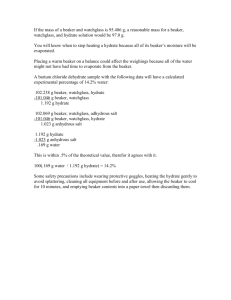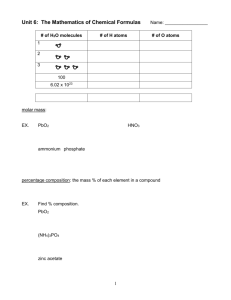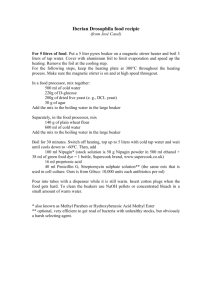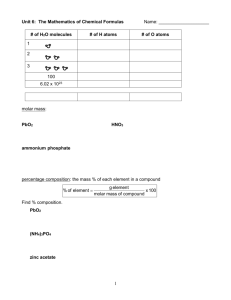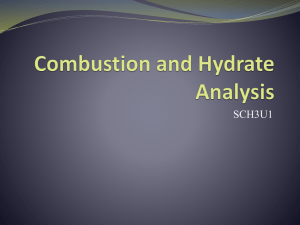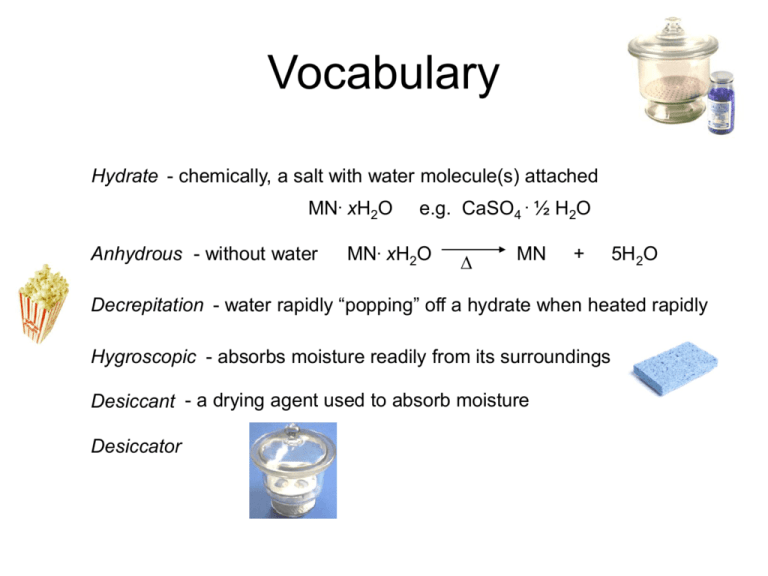
Vocabulary
Hydrate - chemically, a salt with water molecule(s) attached
MN. xH2O
Anhydrous - without water
e.g. CaSO4 . ½ H2O
MN. xH2O
D
MN
+
5H2O
Decrepitation - water rapidly “popping” off a hydrate when heated rapidly
Hygroscopic - absorbs moisture readily from its surroundings
Desiccant - a drying agent used to absorb moisture
Desiccator
Hydrate
Ionic compounds that contain specific ratios of loosely
bound water molecules, called waters of hydration.
Waters of hydration can be removed by heating.
Compounds that differ only in the
numbers of waters of hydration
can have very different properties.
Copyright 2007 Pearson Benjamin Cummings. All rights reserved.
Formula of a Hydrate
Given the following data
BaCl2.3H2O
mass of beaker
47.28 g
A
beaker
mass of beaker and sample before heating
53.84 g
B
beaker + MN + H2O
mass of beaker and sample after heating
51.84 g
C
beaker + MN
molar mass of anhydrous salt
128 g / mol
D
hydrate
6.56 g
MN. xH2O
Step 1A) determine the mass of hydrate (MN. ? H2O)
-
beaker + hydrate
beaker
MN. ? H2O hydrate
53.84 g
47.28 g
6.56 g
Formula of a Hydrate
Given the following data
mass of beaker
47.28 g
beaker
mass of beaker and sample before heating
53.84 g
beaker + MN + H2O
mass of beaker and sample after heating
51.84 g
beaker + MN
molar mass of anhydrous salt
128 g / mol
hydrate
6.56 g
MN. xH2O
anhydrous salt
4.56 g
MN
Step 1B) determine the mass of anhydrous salt (MN)
-
beaker + anhydrous salt
beaker
MN
anhydrous salt
51.84 g
47.28 g
4.56 g
Formula of a Hydrate
Given the following data
mass of beaker
47.28 g
beaker
mass of beaker and sample before heating
53.84 g
beaker + MN + H2O
mass of beaker and sample after heating
51.84 g
beaker + MN
molar mass of anhydrous salt
128 g / mol
hydrate
6.56 g
MN. xH2O
anhydrous salt
4.56 g
MN
Step 1C) determine the mass of water
-
hydrate
anhydrous salt
H2O
water
6.56 g
4.56 g
2.00 g
Formula of a Hydrate
Step 2A) convert grams to moles (salt)
x mol MN = 4.56 g MN (1 mol MN / 128 g/mol MN)
x = 0.0356 mol MN
Step 2B) convert grams to moles (water)
x mol H2O = 2.00 g H2O (1 mol H2O / 18 g/mol H2O)
x = 0.111 mol H2O
Step 3) divide by SMALLEST "# of moles“
0.0356 mol MN / 0.0356 mol = 1 MN
0.111 mol H2O / 0.0356 mol = 3.12 H2O
Step 4) use the ratio to find the hydrate's formula
1 MN . 3.12 H2O (recall, it is not possible to have 3.12 molecules of water)
1 MN . 3H2O
Final Answer
Printable
copy of
LAB
Formula of a Hydrate - Prelab
1) Weigh dry beaker (record mass in data table)
2) Add 1 spoonful of hydrate to beaker (weigh)
3) HEAT: ~10 minutes
gently (low heat) ~3 minutes and HIGH ~7 minutes
4) Cool 3 minutes and weigh
5) HEAT: HIGH ~5 – 7 minutes
6) Cool 3 minutes and reweigh
7) Repeat steps #5 and #6 if “constant weight” is not observed
DATA TABLE
Molar mass of anhydrous salt = 120.3 g
Percentage composition of water = 51.2%
Traditional heating of hydrate using a crucible.
I’ve had very good luck using a beaker.
Analysis
1. What is the mass difference between the hydrate and the ionic compound?
What does this mass represent?
2. To determine the formula of the hydrate, what piece of information do
you need?
Ask your teacher for this information.
3. What is the empirical formula of the hydrate?
Show your work.
Conclusions
1. Suppose the heating did not remove all of the water from the hydrate.
How would this affect your results?
2. List at least two other possible sources of error in this investigation.
you need?
Explore Further
A desiccant is a compound used to absorb moisture from the air.
How could the formula of a hydrate indicate its effectiveness as
a desiccant?

